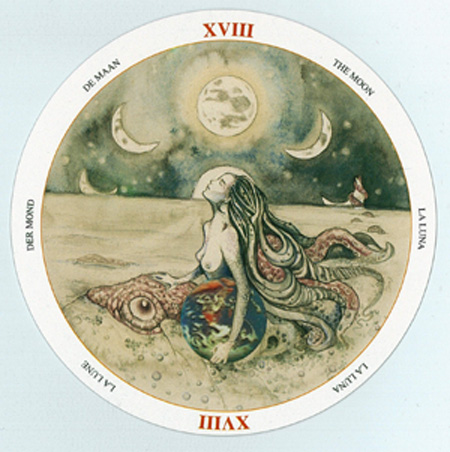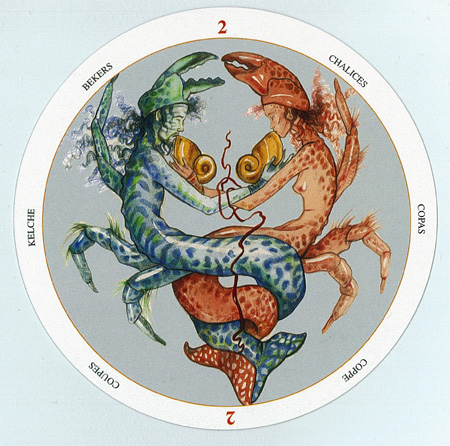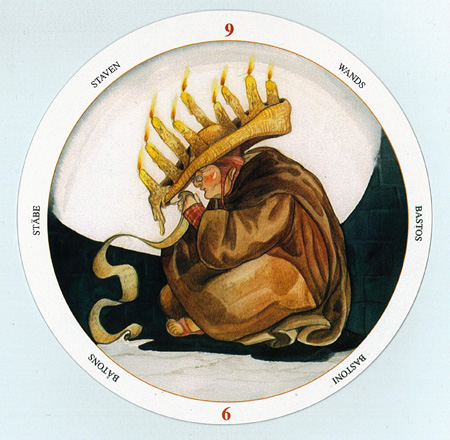
I’ll say it up front: I have a love/hate relationship with this deck. For a conventional reading it often leaves me completely adrift. But for those questions, clients, or situations which border on the unconventional or plunge into the downright bizarre, its unusual imagery and creative twists provide a smorgasbord of intuitive delights.
This deck was clearly meant to be on round cards from the outset. While the artwork of many round decks would seem to do just as well or better in a rectangular format, the Circle of Life Tarot was clearly conceived on a circular canvas. With many cards it is difficult to tell at a glance which way is up. In many cases the perspective is such that you appear to be looking down at the scene from directly overhead.
The cards are nicely rendered in a watercolor style, with a palette based on earth tones. A white border carries the card name in six languages: English, Spanish, French, Italian, German, and Dutch. The titles are small and hard to read at a glance, but therefore do not interfere with the card image.
The characters which populate the cards are a bizarre fusion of life forms. Most have humanoid characteristics, but often crossed with various forms of aquatic, reptilian, insect, and fantasy creatures. The Two of Cups carries the common theme of a couple face to face, drinking from seashell chalices. This couple, while having human faces, have long entwined fish tails, multiple, spiny, crustacean legs, and their heads are crowned with lobster-claw helmets.
The Circle of Life Tarot is not shy about departing from traditional symbolism of the Tarot. On some cards the artwork does echo the concepts of traditional card meanings, but part of the fun of this deck is trying to figure out the connection between the images.
Although the artwork is decidedly different, the images in the Major Arcana generally stick to traditional concepts. In the Minor Arcana, the traditional stereotypes begin to unravel. Take, for example, the Nine of Wands. Here, a portly human, dressed in a monk-like cloak, sits crossed-legged on the floor, minutely examining a very long strip of paper (a list, perhaps?). On his/her head is a huge sombrero-style hat, with burning candles perched around its brim. Another example is the Two of Pentacles, which shows a snake entwined around the base of a large tree which has two shields painted or hung on the trunk.

Although the imagery of the deck is off-beat, it is never threatening or harsh. Some cards border on the whimsical, but without becoming silly or cutesy. The Knave of Chalices show a peasant-dressed woman, bearing a large water vessel on her back, being carried through the air by bluebirds.
The LWB is as obscure as the imagery, and is little help in decoding the cards (but it does it in five languages – omitting the Dutch). The descriptions do not provide clear meanings, but read more like fortune cookie aphorisms, and often seem to have little relation either to traditional card meanings or to the images appearing in the cards. Taking examples for the two cards just described above, we have for the Nine of Wands, “Strength and Wisdom are gained by tempering our own will.” For the Two of Pentacles, “Every struggle brings moments of doubt and indecision that are forgotten after victory has been attained.” If you can twist your brain a bit, you can start to see a connection, but it takes some thought.

The LWB also includes a description of a spread using 24 cards. The method is complex, entailing numerous cycles of the querent selecting and turning over cards, then reshuffling the 24 for further analysis. I simply use the cards in a conventional spread of choice, or as a free form sequence for readings.
Given the non-traditional style of the Circle of Life Tarot, along with the challenges of the LWB, this is not a deck for beginners. But it is a fun and thought-provoking deck for experienced readers looking for something that roams outside the fence of traditional Tarot decks. Perhaps it’s just the thing for those readings that wander into the bizarre side of life.
~review by Nancy Waterstone
first published in the ATA Quarterly Journal, Winter 2012 issue
Lo Scarabeo, 2007
78 cards with instruction book
$22.95
